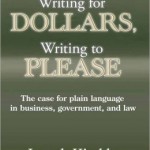6 lessons from my book writing experience
Thinking about writing a book?
Before you start, please consider six lessons from my writing experience with Financial Blogging: How to Write Powerful Posts That Attract Clients. They’ll make your writing process flow more smoothly. If you enjoy this post, I’ll follow up with posts about my book’s production and marketing.
1. Decide on traditional vs. self-publishing
Your decision about whether to seek a traditional publisher or to self-publish will affect your writing process. Historically, the traditional route requires writing a proposal, finding an agent, and then seeking a publisher. To attract an agent and publisher requires having a “platform”—a readymade audience of people who’ll buy your books—in addition to expertise and a strong proposal. The platform is important because today’s publishers don’t do much to market books they don’t see as blockbusters.
I toyed with the idea of going the agent-publisher route, even though I had a strong hunch that I’d self-publish because of my book’s niche. I liked the idea that someone else would manage the production process. Plus, it would be cool to say “I have an agent.” I signed up to meet with three agents at the April 2011 member-only pitch sessions at the annual conference of the American Society of Journalists and Authors.
Surprisingly, the agent whom I met—only one of the three meetings panned out—asked me to send him my proposal and sample chapter. I floated up to Cloud Nine. By the way, here’s a link to my 2011 one-pager.
Unfortunately, my proposal and sample chapter didn’t get results from the agent. He responded once via email, but then ignored my email and telephone follow-ups. I wish he could have said, “Sorry, your book isn’t right for me.”
Anyway, the reason I stress the traditional vs. self-publishing decision is its impact on your writing process. If you go the traditional route, you should wait to write your entire book until after you snare an agent—and probably after the two of you land your publisher. For advice on pursuing an agent and publisher, here are some sources:
- “Agents and book proposals” by Pat McNees
- Publishers Marketplace
- Chuck Sambuchino’s Guide to Literary Agents Blog
If you’re self-publishing, you can start writing whenever you feel ready.
2. Test your concept
If you’d like people to buy your book instead of simply accepting it as a free giveaway, you should test your target market’s interest in your book idea.
If you write a heavily trafficked blog that’s narrowly focused on your book topic, that’s a good indicator of interest. You can also look at your blog’s statistics or run a poll on your blog (or in your e-newsletter) to refine the focus of your book.
Presentations and classes are another great way to test your book idea. My book actually grew out of a class that I taught. I figured that since advisors were willing to pay a three-figure fee to take a class with me, there’d probably be interest in a book, too.
3. Develop a plan
My plan was to take my class notes and write them up, paced by the need to provide drafts on the schedule of my creative writing group. To write your book as quickly as possible, you’ll benefit from starting with a
- Outline or other structure for your book
- Schedule for hitting milestones in your book creation process
Having a plan for your content before you write will allow you to write more efficiently and identify the focus of each chapter in advance. This will prevent the painful task of rearranging it later.
If you don’t have an outline, consider mind mapping your book’s structure. That’s how I figured out the structure of my blogging class, which became the foundation of my book.
Creating a schedule or some form of accountability will help discipline you to work on your book. You, like me, may find it hard to squeeze your book into your daily routine. A target of one chapter per X number of weeks may help.
4. Get support
Get whatever support you need to make your book project easier.
The Nobscot Niblets, the creative writing group that I participated in, was invaluable. At our twice-a-month meetings, they gave me deadlines, critiques, and encouragement. Without them, I would never have started my book. Nor would I have finished it as soon as I did.
You may be able to find a local writing group through MeetUp.com. That’s how the Niblets started, though I was brought in by a friend.
If groups aren’t for you, a writing coach or accountability buddy may help. I’ve discussed the buddy approach in “How a blogging buddy can help your investment or financial planning blog.”
5. Test your material
It’s hard for you to experience your book through your readers’ eyes, so ask others to read your book to give you feedback. This could mean reading individual chapters along the way and then reading the complete manuscript.
The Nobscot Niblets did both kinds of reading for me. They convinced me that I needed to add some topics, such as compliance, that I wasn’t eager to cover. Their reading of the complete manuscript prompted some changes in my chapter order, in addition to numerous tweaks.
I also enlisted a writing instructor and several members of my target audience to read my book. Their reading from different perspectives tested the effectiveness of my book.
6. Manage your images
Images, tables, and other graphic elements may make your message easier to understand, but they’re also a big pain when you format your book.
To minimize the pain, follow these rules:
- Only include graphic elements that contribute significantly to your readers’ understanding. I cut quite a few screenshots from my book during its production phase.
- Snap any photos at a high resolution. Unfortunately, I had no idea when I took the two photos in my book that I’d need them for the book. They look okay, but not great.
- Limit your use of computer screenshots because their resolution typically isn’t very good. Substitute typed text for screenshots when possible. Screenshots can work, but they may not look as crisp as the rest of your book.
- Keep your graphic elements small in terms of height and width if possible, assuming that you’re planning to make your book available in an electronic format. A table that looks great printed on 8 ½” x 11” piece of paper won’t display well on a tiny screen.
- Limit special formatting. In my book, the two-column formatted text that needed to line up was a royal pain during book production.
These are my best tips to help you complete a draft of your book.
Interested in learning my tips for turning your manuscript into a published work? Let me know.




Thank you for sharing your experience. As always, I find your advice very helpful.